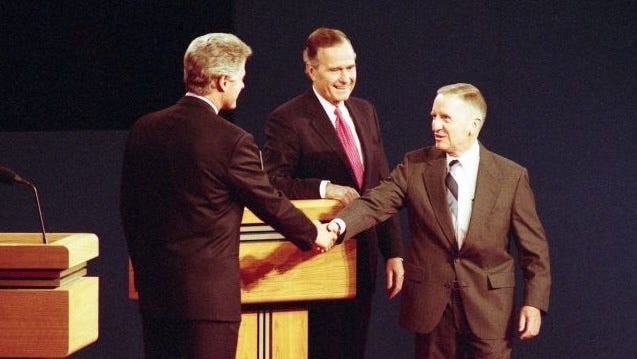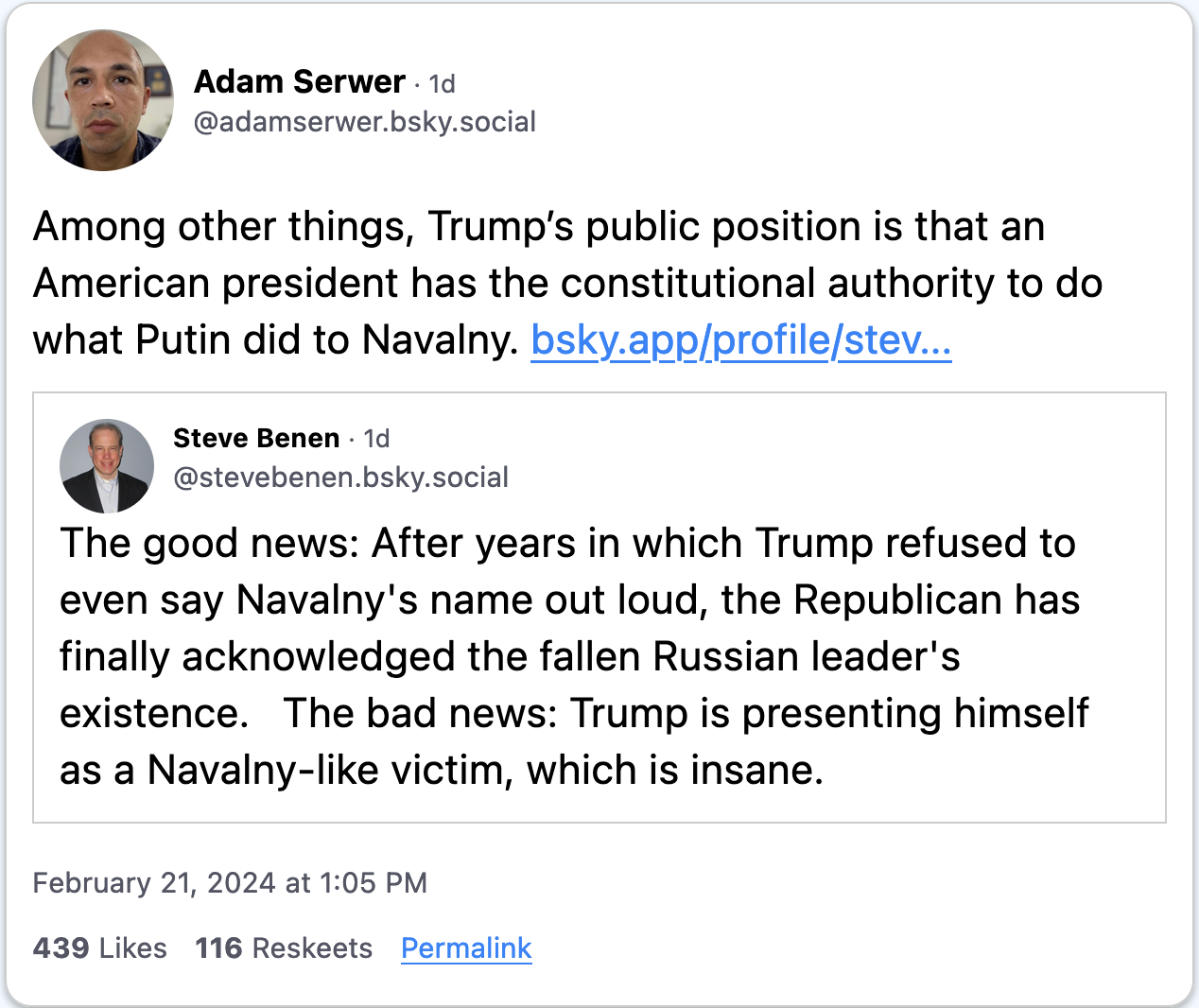The Third Party Fantasy
Holding out for an H. Ross Perot

Voters may be unhappy with the choice between Donald Trump and Joe Biden, but there’s almost no chance a third-party or independent candidate will win the US presidential election. No third-party or independent candidate has ever come close—and the road for third-party and independent candidates has gotten harder as politics in the US has become more partisan.
Look, I get it. I do. American voters consistently say they’d prefer different presidential nominees. Majorities have unfavorable opinions of Donald Trump and of Joe Biden. I personally think the choice between Trump and Biden is clear. Trump is a staggeringly corrupt authoritarian, who lacks even a basic understanding of most important issues. He attempted to hold on to power after he lost the 2020 election and has explicitly promised to persecute his political opponents. Biden meanwhile has run an effective administration under difficult circumstances and—crucially—is not abusing the power of his office. But a majority of voters are concerned about Biden’s age. He’s only four years older than Trump, but he seems old; he doesn’t inspire confidence in his ability to defeat Trump or do the demanding job of president for a second term.
Moreover, if you’re conventional conservative—if you favor low taxes and less regulation, for example—but aren’t a white nationalist, Christian suprematist, or QAnon believer, there is no presidential candidate who represents you. Of course, there are always voters whose views aren’t represented in any two-party race. Progressives and MAGA voters have rarely been well represented in national elections. But the lack of a center-right candidate represents a seismic shift, considering the center-right dominated US politics for more than thirty years after Reagan’s election. Marginalized conservatives—and the wealthy business interests allied with them—have been left to cast around for a viable candidate to represent them.
Nevertheless, a third-party candidate almost certainly isn’t going to win the presidency in 2024. Challenging either party requires building a new national coalition and would likely take years. Unless the parties nominate different candidates—and it doesn’t look like either will—the next president is going to be either Donald Trump or Joe Biden. We’ve now had 43 straight presidential elections without electing someone who wasn’t either a Democrat or a Republican. The last elected president from another party was Zachary Taylor in 1848. Taylor was hardly a third-party candidate himself, since the Whigs were one of the two major parties at the time. In fact, no third-party candidate has won the presidency since the establishment of the two-party system in the US. That’s unlikely to change this year.
Third-party candidates have never even come close. The closest in my lifetime was wealthy businessman Ross Perot. Perot managed to win almost 19% of the national vote in 1992 against George H. W. Bush and Bill Clinton, but he still didn’t win a single electoral vote. Before that—all the way back in 1912—former President Teddy Roosevelt won more than 27% of the national vote to beat out Republican incumbent William Howard Taft for second place. But Roosevelt essentially split the Republican vote, and ended up losing to Democrat Woodrow Wilson by more than 14 points and 350 electoral votes.
The road for third-party candidates has just gotten harder as American politics has become more partisan. None of the potential third-party candidates has any real chance of challenging the major party nominees. There’s no Teddy Roosevelt waiting in the wings. Robert F. Kennedy, Jr. is a crank with limited appeal to a broader electorate. The polls that show him appealing to a third of voters aren’t an indicator of informed interest in his candidacy so much as an expression of dissatisfaction with the other choices. More plausible alternative candidates don’t have the name recognition or the stature to challenge Trump or Biden. Centrist group No Labels was reportedly considering former Maryland Governor Larry Hogan and West Virginia Senator Joe Manchin, but both declined to run after testing the waters. Both have bipartisan appeal—Hogan was the Republican governor of a solidly Democratic state and Manchin is a Democratic senator in a solidly Republican state—but they’d each likely be the second choice of both Republicans and Democrats. Neither would be favored to win their own home state.
While no third-party candidate has come close to winning the presidency, third-party candidates have altered the outcomes of presidential elections. Green Party candidate Ralph Nader likely swung the 2000 election to George W. Bush. Green Party candidate Jill Stein may also have swung the 2016 election to Donald Trump. Neither had anything close to the support they would have needed to win the presidency—they each won less than 3% of the popular vote—but both may have drawn enough votes that would otherwise have been won by the Democrat to affect the results. A centrist candidate like Hogan or Manchin would likewise have more appeal to voters who would otherwise vote against Trump than who would vote for him. So while they almost certainly wouldn’t win, there’s a significant chance they’d be the reason Trump wins.
I don’t want to minimize Trump and Biden’s real flaws. Trump’s record should absolutely disqualify him from consideration for office. If Biden really isn’t capable of mounting a campaign—much less of doing the job of president—he should also step aside. It’s possible that Democrats would be better off nominating a younger, more vigorous candidate. But it’s always easy to believe the grass would be greener if someone else were running. Trump and Biden are the presumptive nominees of their parties because alternative candidates were unable to make a stronger case. Biden won the nomination in 2020 in part because it was harder for Republicans to portray him as socialist, deviant, or unAmerican. Biden gets attacked for his age in part because he isn’t vulnerable to other standard attacks on Democrats. Vice President Kamala Harris, Biden’s obvious alternative, polls even worse than he does. The truth is that all the other potential candidates have flaws too. The reality of our politics is that after six months of scrutiny and partisan attacks even the strongest candidate would seem critically flawed.
Voter dissatisfaction with the major party nominees seems like an opportunity for a third-party candidate. I think that’s an illusion. Negative partisanship in the US—we’re more motivated by our opposition to other parties than we are by our support of our own—has left us unhappy with all our choices. I don’t think it would make much difference if other candidates were running. Voters have repudiated Trump in every election since 2016. I think they’re likely to do so again in spite of Biden’s flaws as a candidate—especially if Trump is convicted of a felony—although with Biden’s persistently low polling I’m less confident than I was. Trump’s chances of winning are higher if a third-party or independent candidate manages to win a significant percentage of votes. Metaculus gives a third-party or independent candidate a 19% chance of winning at least 5% of the national vote. But I think the chance a third-party or independent candidate actually wins the presidency is close to zero.
My Forecasts
68% chance the Democratic nominee wins the presidency in 2024
10% chance a third-party or independent candidate wins at least 5% of the popular vote in 2024
>1% chance a third-party or independent candidate wins the presidency in 2024
All my recent predictions are on Fatebook here.
If you enjoyed this post, please share it with others! Telling the Future depends on recommendations from readers like you to reach a wider audience.





I appreciate how you don't mince words Robert. On a somewhat related note, what do you make of the recent talk about replacing Biden at the top of the ticket (supposing party insiders could convince him to step aside)? Personally, I think there would likely be more downside than upside, but it seems that Nate Silver and Ezra Klein think it would be a good idea.
Oooft 68%. Wow. I'm at about 49% big gap